How Do You Keep Marigolds Blooming All Summer? Expert Tips and Advice
Do you want your marigolds to bloom beautifully all summer? These vibrant annual flowers can be a stunning addition to your garden.
Keeping marigolds blooming involves giving them the right amount of water, providing the nutrients they need, and deadheading regularly. When marigolds are cared for with these simple steps, they’ll reward you with countless blooms.
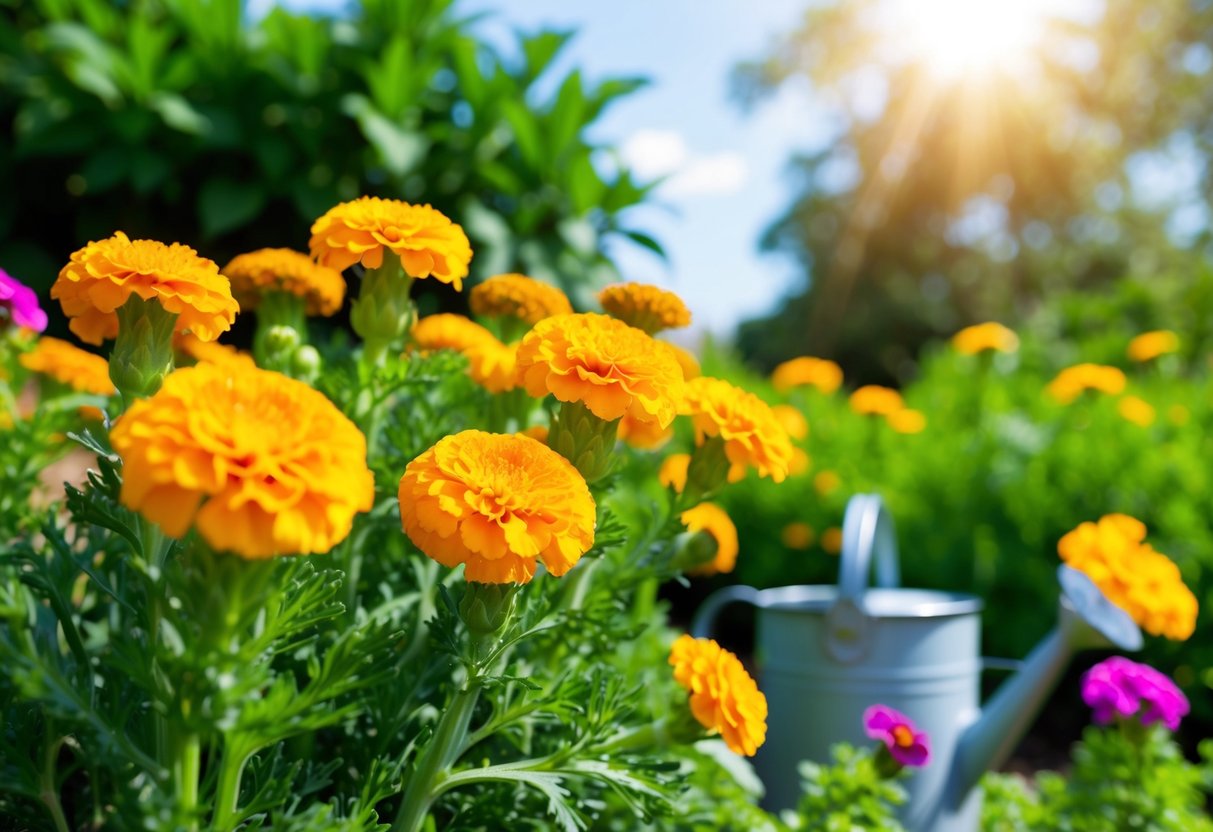
Make sure your marigolds are planted in garden soil that isn’t too rich, as they actually prefer leaner conditions. Watering should be done at the base of the plant to avoid damaging the blooms.
Placing marigolds about 8 to 12 inches apart allows enough space for them to flourish. With this spacing, your garden can be full of color without overcrowding.
If you love the idea of a low-maintenance plant that keeps on giving, marigolds are a fantastic choice. With a little attention and care, your garden will be bursting with these cheerful flowers all summer long. Curious to know more? Dive into the full article to learn how to make your garden a marigold paradise.
Choosing the Right Marigold Varieties

Choosing marigold varieties is important for their growth and bloom. You can choose from several types like African and French marigolds depending on your climate and garden size.
Understanding Different Marigold Types
Marigolds come in various types, each with its unique charm.
African marigolds (Tagetes erecta) are known for their large, showy blooms and can reach up to two feet in height. These are great for making a big impact in your garden. On the other hand, French marigolds (Tagetes patula) offer smaller, bushy plants with vibrant flowers in red, orange, and yellow. These are ideal for smaller spaces.
Signet marigolds (Tagetes tenuifolia) are perfect if you prefer delicate foliage and tiny flowers with a citrusy scent. These are great for borders and even edible gardens. Knowing these differences helps you select the marigold that suits your garden’s needs.
Selecting for Your Climate and Garden Space
Climate and space are key factors when selecting marigold varieties.
If you live in a warm and sunny region, African marigolds might be perfect, as they thrive in full sun and well-drained soil. These taller varieties need a bit more room, so ensure you have ample garden space.
In cooler areas or if you have limited space, opting for French or Signet marigolds may be a better choice. They adapt well to pots and small garden beds. If you’re looking for versatility, consider mixing a few varieties to create a colorful, pest-resistant garden.
Planting and Initial Care
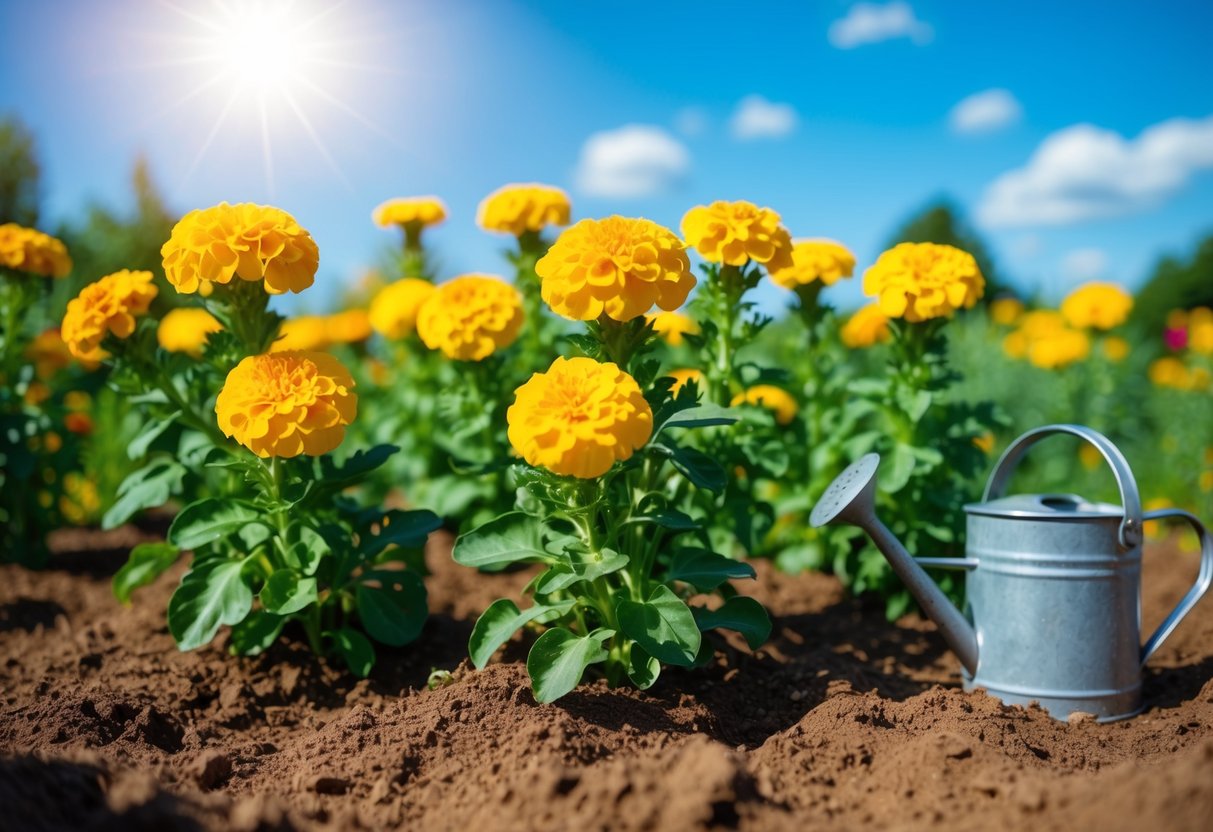
To keep your marigolds blooming all summer, focus on planting them correctly and providing initial care. It’s essential to sow seeds the right way, ensure proper soil conditions, and optimize the light for young plants.
Sowing Marigold Seeds Successfully
Start by planting marigold seeds after the threat of frost has passed. Sow the seeds about an inch deep and one inch apart in your garden. Creating this space helps them grow without competing for nutrients. If you prefer using containers, fill them with a quality potting soil mix.
Keep the soil moist but not waterlogged during the germination period. This ensures that seeds develop properly without rotting. Patience is key, as germination can take about a week to ten days. Providing the right environment helps your seeds develop into healthy seedlings.
Ensuring Proper Soil Conditions
Marigolds thrive in soil with a neutral pH level, typically between 6.0 and 7.0. Test your garden soil to make sure it falls within this range.
Correcting soil pH is important for marigold health and can be done by adding lime to raise pH or sulfur to lower it.
Use well-draining soil to prevent water from pooling around the roots. If you’re planting in containers, choose a commercial potting soil that promotes drainage. Good soil preparation will provide the nutrients your marigolds need.
Optimizing Light for Young Marigolds
Place your marigolds in an area where they can receive full sun. These plants thrive with at least six hours of sunlight daily.
Make sure the growing spot has good exposure to encourage robust flowering and growth.
If you start seeds indoors, use grow lights to simulate sunlight. Position the lights about 2 inches above the seedlings. This prevents them from becoming leggy and ensures healthy growth. Once seedlings are strong and temperatures are consistently warm, transplant them outdoors.
Maintaining Healthy Marigolds
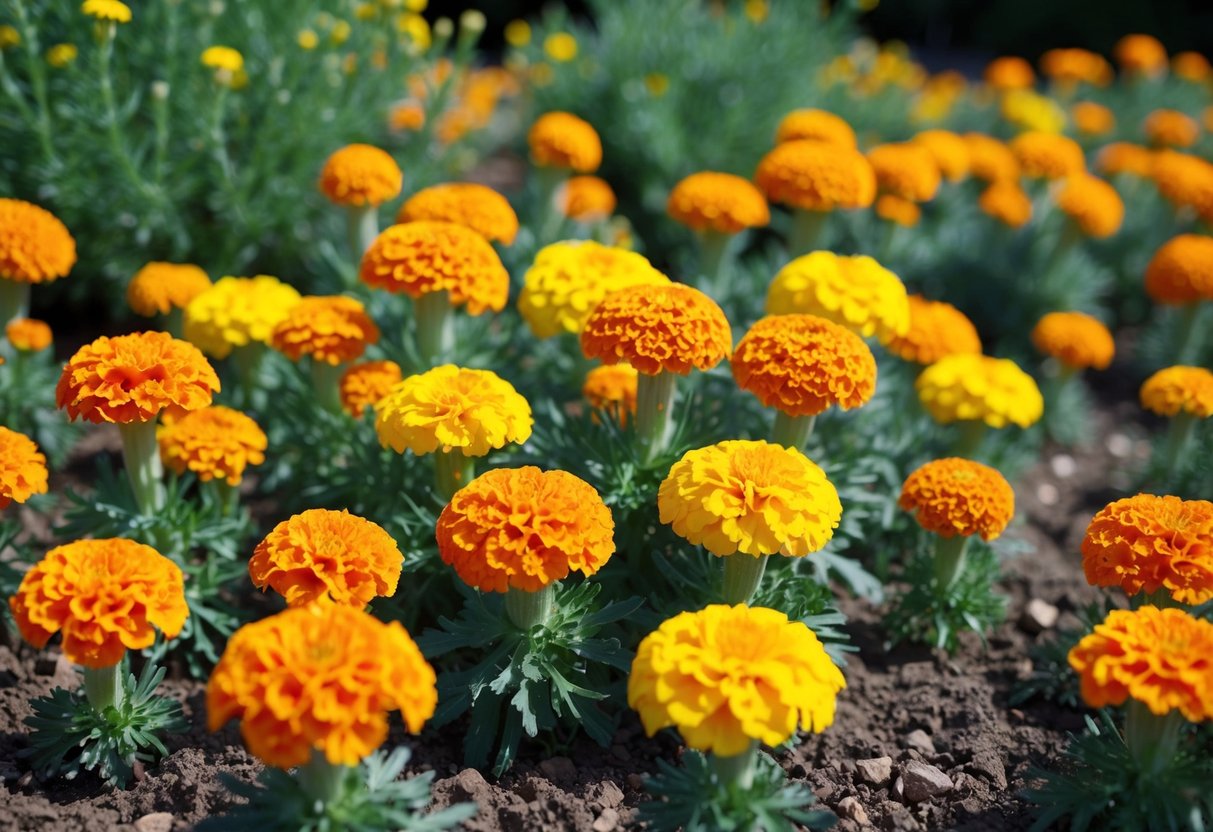
To keep your marigolds blooming beautifully all summer, focus on proper watering, pruning techniques, ensuring good air circulation, and managing pests and diseases. These simple steps can help you maintain healthy and vibrant plants.
Watering Techniques for Marigolds
Marigolds thrive when you water them correctly. Make sure to water at the base of the plant, avoiding the blooms.
This prevents damage to delicate flowers and reduces the risk of fungal diseases. Provide about an inch of water per week, adjusting during dry spells.
Using a soaker hose or drip irrigation system can help deliver consistent moisture without wetting the foliage, which minimizes issues like powdery mildew.
Pruning for Bushier Growth
Regular pruning encourages bushier growth and more blooms. Focus on deadheading spent flowers by pinching off the faded blooms. This redirects the plant’s energy from seed production to creating new buds.
Trim any leggy stems to maintain a compact shape. When you keep the plant tidy, it not only looks better, but also blooms more profusely.
The Importance of Air Circulation
Air circulation is key to preventing diseases. By spacing your marigolds well, you ensure that air can flow freely around the plants.
This helps to dry off any moisture that could encourage mold or mildew growth. Avoid overcrowding and regularly check plants for signs of wilting, as poor air circulation can lead to fungal issues.
Dealing with Pests and Disease
Protect your marigolds by examining them regularly for common pests, such as aphids, whiteflies, and spider mites. Use insecticidal soap or neem oil as needed.
To prevent diseases like root rot and fungal infections, ensure the soil drains well. If you spot signs of nematodes, consider a solarization method by covering the soil with clear plastic to eliminate harmful pests over a few weeks.
Fertilizing for Continuous Blooms
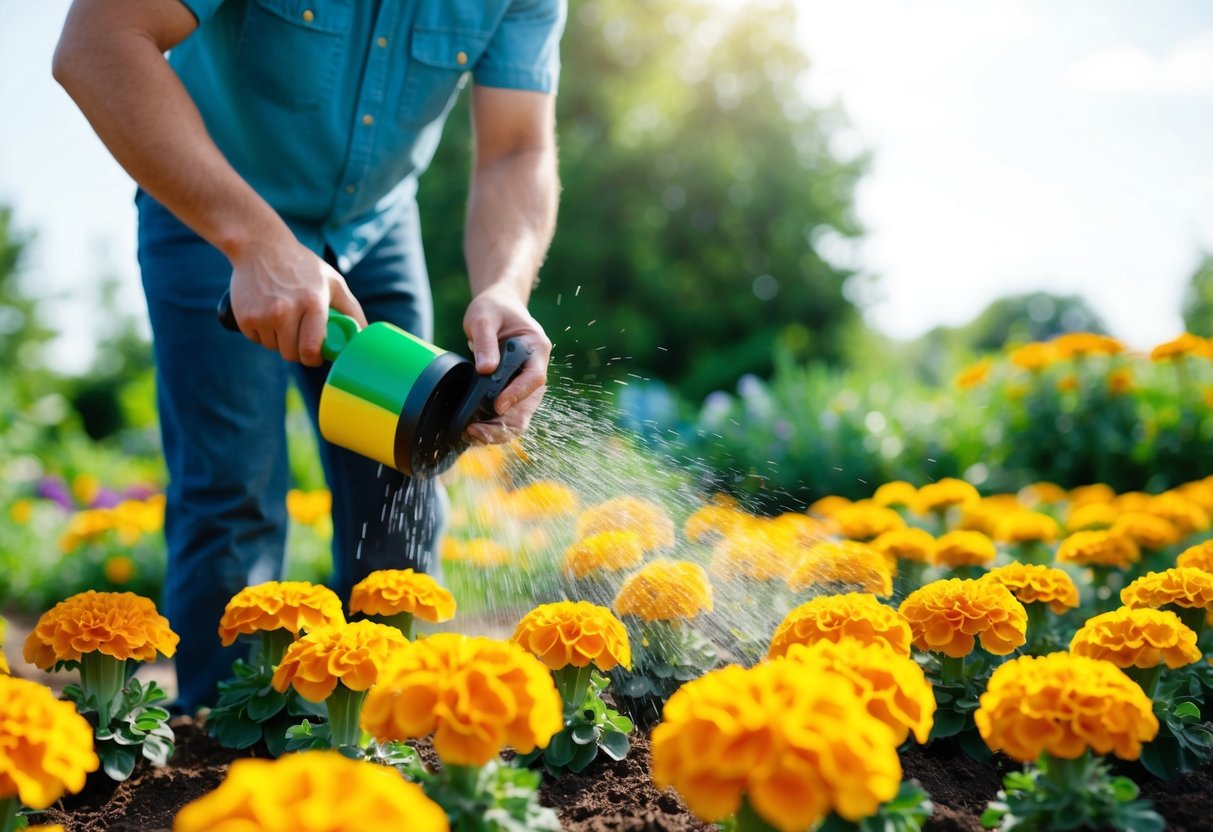
To keep your marigolds blooming continuously, focus on choosing the right fertilizer and knowing when and how to apply it. This helps ensure bushier growth and a vibrant blooming period.
Choosing the Right Fertilizer
When selecting a fertilizer for marigolds, pick one that encourages blooming rather than just leafy growth.
A balanced, all-purpose fertilizer with a 10-10-10 ratio is a solid choice. It provides the nutrients needed to support blooms and maintain plant health.
Liquid fertilizers act fast and are ideal if you notice your marigolds need a quick boost.
For steady and slow growth, you might also consider using a granular fertilizer. These take longer to break down but help maintain moderately fertile soil over time. Proper fertilization is key to achieving vibrant blooms all summer.
When and How to Fertilize Marigolds
Timing is critical when fertilizing marigolds for continuous blooms.
It’s best to fertilize every 4 to 6 weeks during the growing season.
Start early in spring when the first leaves appear. After applying the fertilizer, make sure to water the marigolds thoroughly.
This helps the nutrients integrate into the soil and activate any slow-release granules.
Consistent fertilizing supports blooming by providing the energy your plants need to regrow flowers throughout their blooming period. Be mindful of using too much fertilizer, as this can lead to excessive leaf growth at the expense of blooms. Choose the right type, and you’ll find your marigolds thriving with beautiful blooms all summer long.
Encouraging Prolific Blooming
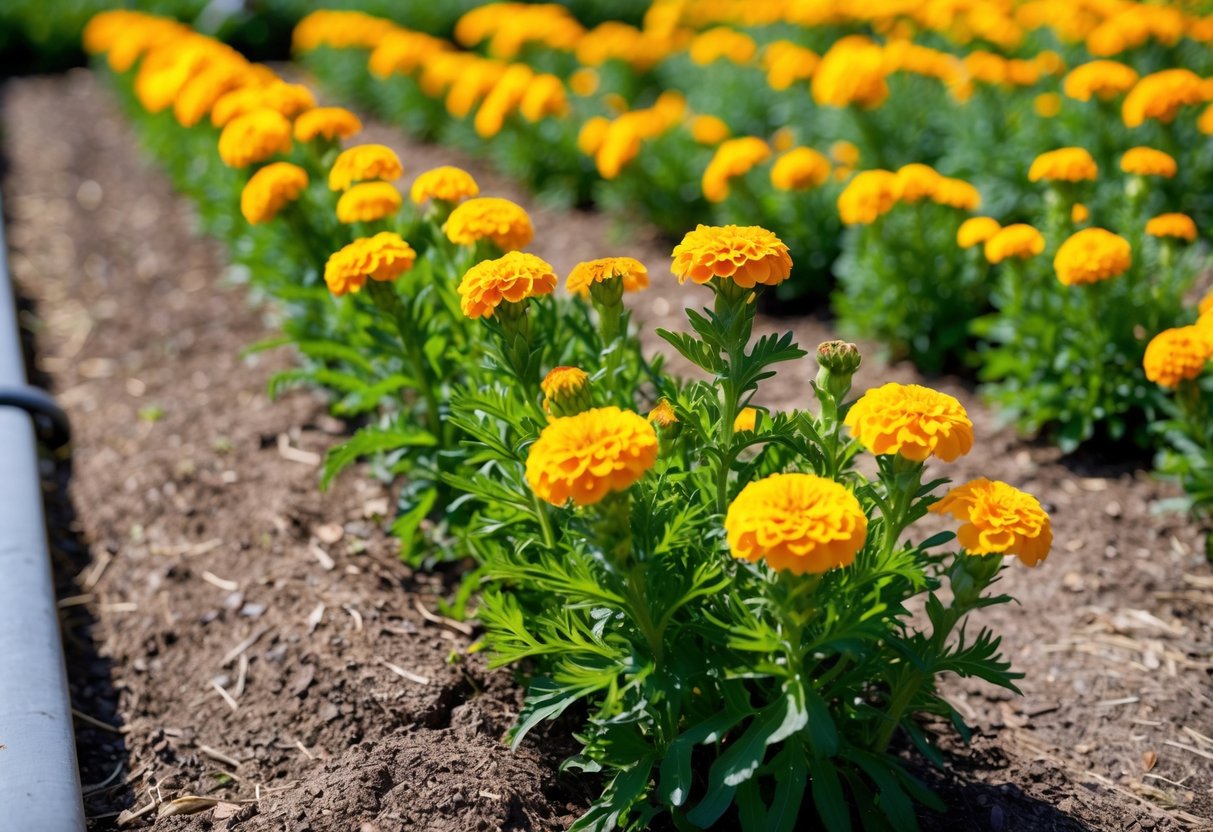
Keeping marigolds blooming brightly in shades of orange, red, and yellow involves a mix of regular maintenance and specific techniques. By focusing on deadheading and providing proper care, you can enjoy continuous blooming throughout the summer.
Deadheading for More Flowers
To encourage more blooms, make deadheading a regular part of your routine. Remove faded or dead flowers by pinching them off at the base.
This simple act prevents the plant from putting energy into seed production and redirects it instead to new blooms. Regular deadheading can result in a bushier plant with more flowers.
Aim to deadhead once a week or whenever you notice spent flowers. This is especially important because marigolds can quickly shift their energy to seed production if old flowers are left in place. Consistent deadheading contributes to healthier plants with a longer blooming period.
Maximizing Bloom Time With Care and Maintenance
Proper care extends beyond deadheading. Marigolds thrive with good watering habits. Always water at the base of the plant to keep petals dry. Wet blooms can shorten their lifespan.
Consider watering early in the morning or late in the evening to minimize evaporation.
Using mulch around your marigolds helps retain moisture and keep the soil temperature stable. This is crucial during hot spells.
Additionally, fertilizing every few weeks will provide the nutrients needed for healthy growth.
Monitor for pests and diseases and address any issues promptly. These steps ensure that your marigolds stay vibrant and flower all summer.







